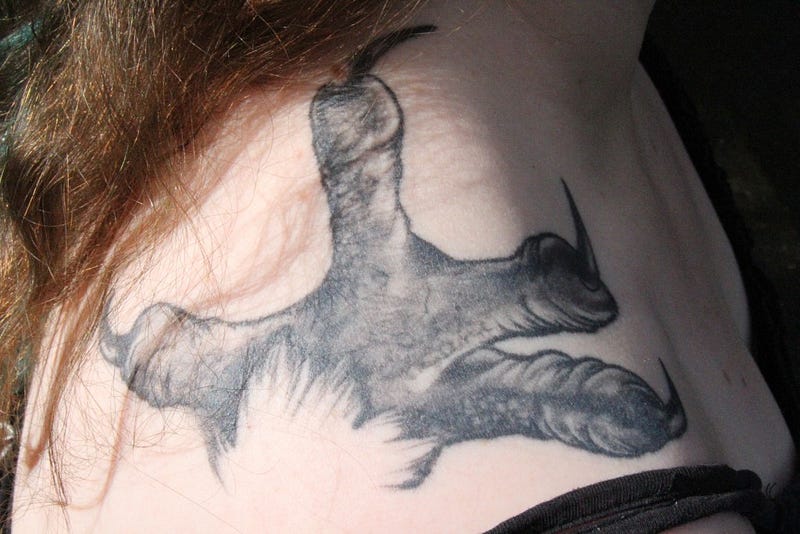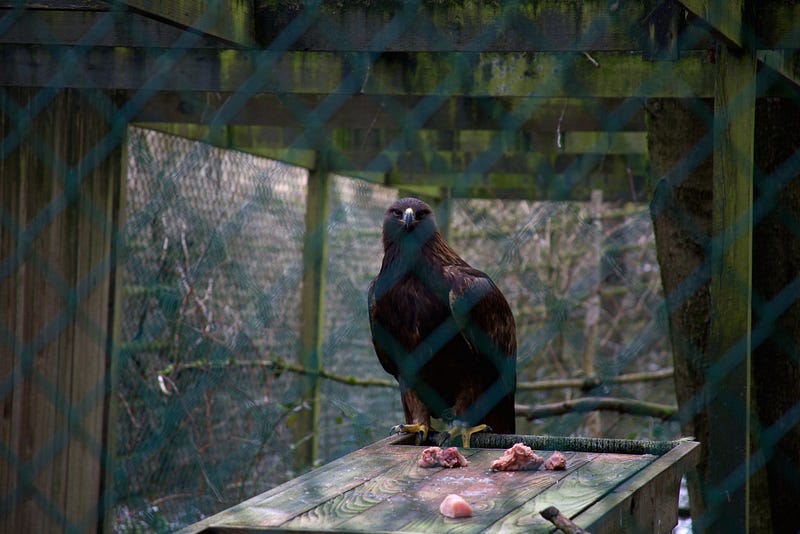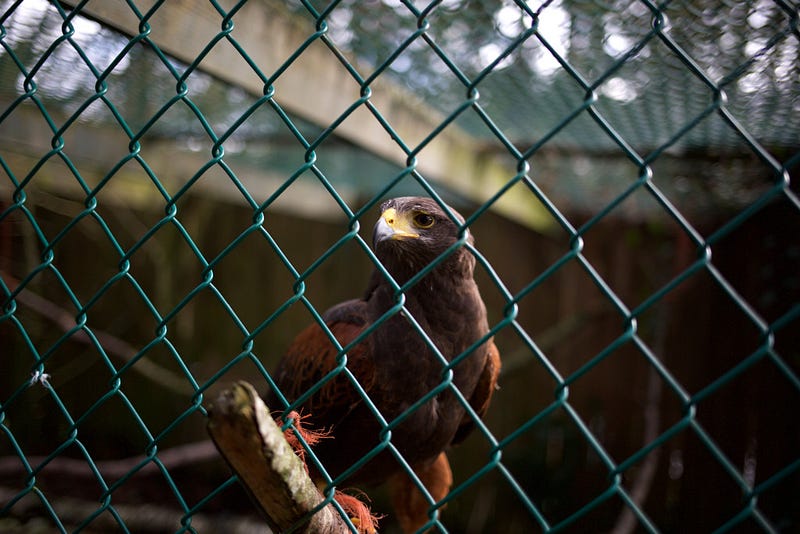Bird’s-Eye View
Sardis Raptor Center works to rehabilitate birds and educate the community
STORY BY ERIK SWANSON | PHOTOS BY BEATRICE HARPER
When Wind Dancer, a golden eagle, was electrocuted by power lines her tail feathers took the brunt of the damage, making flying practically impossible.
Wind Dancer survived the collision. She was taken to a veterinarian who brought her back to health, but her tail feathers grew out corkscrewed. With irregular feathers she struggles to fly and would be easy prey in the wild, so she calls Sardis Raptor Center her home. When she came to Sardis she received the care she needed, but it was too late for full recovery.
Sardis was founded by Sharon Wolters in 1989 as a nonprofit organization based in Ferndale, Washington. Their focus is to provide shelter and care for raptors that have been injured.
Kelina Victor, a Sardis volunteer, has a large tattoo on her right shoulder of Wind Dancer’s talons. From the way it’s positioned, the piece gives the impression that the talons are still there, attempting to lift her off the ground. It’s the size of a basketball player’s hand and Victor says Wind Dancer’s claw, in reality, is even bigger than the tattoo.

“She has this look in her eye that says, ‘I’m wild,’” Victor says of Wind Dancer. She is the only show bird at the center that was not bred in captivity.
Another volunteer at the center, one who gives free tours every Saturday, says many of the birds taken in have injuries that prohibit them from returning to the wild. They are the second largest raptor rehabilitation center in the world — second to Alaska Raptor Center. Raptor are birds of prey that hunt with their talons.

The raptors arrive from a variety of places and the center has a hotline for those who encounter an injured bird in the wild. They have received birds from veterinarian clinics and animal rescues as far south as Oregon and into eastern Washington.
Human development is the main reason for the injury of raptors that come to them Victor says. Cars, telephone wires and sometimes guns; the penalty for which is a year in prison and a $5,000 fine, according to the U.S. Department of Fish and Wildlife. The first priority of those at Sardis is to rehabilitate the birds that come to them and close behind that is the mission to educate the community on the dangers that humans pose to the raptors.
Victor says its hard to know exactly how many raptors they have been able to set free, but after 17 years of operation, it is safe to say the number is in the hundreds.
Every raptor they take in has a story, many of them tragic.
Thunder came to Sardis after being raised in a birdcage. The hawk was discovered in a drug bust. She was malnourished and missing half a wing. She is off balance when held and, for stability, puts her good wing on the trainer’s shoulder as she grabs their collar with her beak.
From Thunder’s enclosure, the calls of 10 bald eagles can be heard at feeding time.
The bald eagle space is both sobering and exciting. There is a beach with logs and branches for perching and pebbles and rocks make up the ground coverage, simulating their natural habitat. It’s not hard to imagine that they are happy here, even when considering that their injuries prohibit them from the Pacific Northwest beaches that they belong to.
There is one bald eagle who is in perfect physical condition. Einstein will continue to live at the center in her own enclosure, not leaving with the other birds that are rehabilitated. She lacks natural instincts that would allow her to survive in the wild.
Einstein had a human family before living at Sardis. According to the Wildlife Center of Virginia, raptors are born without the understanding of their species and visually learn from their parents. Einstein’s actions reflect that of her human family because she didn’t know any other lifestyle after they took her in at a young age.

Einstein’s family lives in Idaho, but comes to visit from time to time. She loved toys; her favorite is a Rubik’s Cube that the kids gave her. She was protective of the children, threatening the neighbors when they would visit. Einstein’s fate was sealed when her protective instincts led her to injure a neighbor. She flew away to avoid capture when an agency came to collect her. It was only after her she was temped by her favorite toy that the agency was able to collect her.
Some raptors just get dealt a bad hand.
Clove is a sparred owl that came in as a chick 6 years ago with several of his brothers and sisters. A sparred owl is a mix of a spotted owl and a barred owl. His siblings were raised, nurtured and released to the wild by Sardis but Victor says that Clove just wasn’t sure how to owl.
The owl sits on a branch in its enclosure and stares at a child in a blue rain jacket with deep, golf ball size black eyes. He moves his head every few seconds but seems to be immersed in another world, one that man will never understand. Victor says it took two years before Clove figured out he could perch on branches.
Clove sometimes doesn’t realize he has the ability to see by turning his head around 270 degrees. To make up for his imaginary lack of dexterity he will contort his body in such a way that his head disappears in his feathers.
It’s easy to forget the power of the raptors as they perch calmly in their homes.
Each species at Sardis has evolved for a life in the free, open air. There are many dangers, but their senses and instincts have developed to protect them. Their injuries, mental or physical, stop them from returning to the wild. Some raptors at the sanctuary will never be well enough to return to their natural environment. Their injuries would make them easy targets, like Wind Dancer who can no longer fly effectively or Einstein, who has too much dependency on humans.
The important thing is that they are being cared for. Raptors are an important link in the food chain and provide for balance within an ecosystem. They are increasingly impacted by human technology and will continue to rely on resources such as Sardis to survive.
